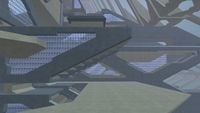Forerunner City
From Halopedia, the Halo wiki
- "all I can say is, imagine a beard trimmer, and each blade of the comb is the size of manhattan, each with tiered 'hoods."
- — Paul Russel[1]

"The Lost City"[3], also known as "Forerunner Condo" to Bungie and "Cuesta Verde" to Vic DeLeon[4] , was a visual look-development level created during the development of Halo 3. It was cut during the development process, as the space had grown so immense that "it could be a game in itself".[3]
The final iteration's exterior appears to have influenced the design of the final game's Cartographer: the forward half of the city, especially its spire, is virtually identical to the map room's exterior structure. A building identical to the third iteration was also featured in the Halo Legends episode Origins.[2]
Development and design
Built by Bungie environment artist Paul Russel, the level was to be based around a massive Forerunner city and served as a visual look-dev test for the game's campaign. By the time of working on his third Halo game, Russel's ideas for Forerunner architecture were beginning to run thin, and the artist wished to create a city that "got past" modern notions of cities - instead of individual buildings, the entire city was to be made of one single building.[5] The project aimed to crate spaces that had cultural function and implied Forerunner daily life via the architecture, as well as indicating what Forerunner values were.[6][7] More than just "cool shapes with mysterious purposes", the structure was to tell a story of the people who used it.[8]
At first, Russel started exploring the idea by designing different types of skyscrapers based on Forerunner aesthetic, gradually adding detail until discarding the idea of a conventional, human-like city in favor of a more solid and defined arcology design. Russel then built several architectural components, stacking them together to form a single, massive structure which he then flipped on top of itself. However, this design was also discarded and replaced by a single building covered in an ornate, extremely detailed cantilever pattern. The final design incorporated a variation of the repetitive cantilever structure based around a massive arcology structure, featuring an expansive interior space with complex structural elements nestled within the superstructure.[3]
In total, there were around ten versions of the city produced.[9] Once the architectural blockout was made, it was passed on to Vic Deleon, who populated the area with vegetation, entropy and lighting and other detail[10], working for around three weeks on the project alongside a cut level called "Tsavo Township" before being moved to making maps for Halo 2 DLC.[11] By this time, the fiction surrounding the structure that it was to be a housing complex for Forerunner scientists living on the ring - possibly the Librarian's team.[4] The idea of this iteration was to design an abandoned living space with a courtyard, that had fallen into disrepair.[10]
Gallery
Vic Deleon's art pass
The near-final iterations by Vic DeLeon, running in the "Halo 2.5-3" engine, c.2005.[10]
Sources
- ^ Paul Russel on Twitter
- ^ a b Paul Russel on Twitter: That's a trace of a screenshot I took of one of the concepts. I think version 3 of a city.
- ^ a b c Picasa: Paul Russel > Halo 3: The Lost City (defunct, Archive)
- ^ a b Vic DeLeon on Twitter: We called it Forerunner Condo. I called it Cuesta Verde phase 4. The fiction behind it was a supposed housing complex for Forerunner scientists living on the ring. Maybe for the Librarian's team? I don't really remember.
- ^ Paul Russel on Twitter: Thanks! I wanted to get past our current notion of cities, instead of individual buildings, city is a single building.
- ^ Paul Russel on Twitter: I had a lot of ideas for the discarded forerunner city. In terms of creating spaces that had cultural function...
- ^ Paul Russel on Twitter: ...tried to imply Forerunner daily life through architecture. What their values were. How function and form worked...
- ^ Paul Russel on Twitter: ...probably the most interesting thing I took on, because it wasn't just cool shapes with mysterious purpose. Telling a story
- ^ Paul Russel on Twitter: Here's one I didn't put up. There were probably 10 different versions of the city.
- ^ a b c Vic DeLeon on Twitter: So here's three shots taken in-game wayyy back in 2005 running a version of the #Halo 2.5-3 engine. The idea was to design an abandoned Forerunner "living space" with courtyard, and fallen into disrepair. @Dr_Abominable made the original structures and I modified, added entropy
- ^ Vic DeLeon on Twitter: I spent roughly three weeks working on both this and a test for Tsavo Township (which was put on hold) until I was moved over to making multiplayer maps for the Halo2 DLC.










